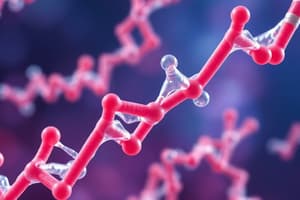Podcast
Questions and Answers
What are the two most common types of enzyme structures?
What are the two most common types of enzyme structures?
Globular and fibrous
How do globular enzymes achieve stability while maintaining flexibility?
How do globular enzymes achieve stability while maintaining flexibility?
By having many secondary protein folds
What makes fibrous enzymes structurally stable?
What makes fibrous enzymes structurally stable?
Being long chains of amino acids connected without bends or loops
What causes variations in enzyme structures between species and individuals?
What causes variations in enzyme structures between species and individuals?
How are most enzymes secreted in the body?
How are most enzymes secreted in the body?
What are the three main parts of an enzyme?
What are the three main parts of an enzyme?
Why is the structural arrangement of enzymes important for their function?
Why is the structural arrangement of enzymes important for their function?
How many specific types of substances or compounds can each enzyme break down?
How many specific types of substances or compounds can each enzyme break down?
What can happen to the enzymatic process if the temperature is too hot or too cold?
What can happen to the enzymatic process if the temperature is too hot or too cold?
What are cofactors, and why are they important for enzyme function?
What are cofactors, and why are they important for enzyme function?
Give an example of a cofactor that serves to stabilize enzyme structures.
Give an example of a cofactor that serves to stabilize enzyme structures.
Flashcards are hidden until you start studying
Study Notes
Enzymes are proteins produced by living organisms, including humans, that act as biological catalysts, enabling chemical reactions to occur faster and more efficiently. They play crucial roles in various cellular processes such as digestion of food and absorption of nutrients into cells. To understand how enzymes work, it's important to know their structures and functions.
An enzyme has three main parts: a substrate-binding site where a reactant attaches itself; the active site where the reaction takes place; and the product-binding site where the end result is released from the enzyme once its job is done. This structural arrangement allows them to function effectively despite being relatively simple molecules themselves. Each enzyme can only break down one specific type of substance or compound. However, some enzymes can recognize different compounds with related molecular shapes and thus share similar capabilities for breaking down those compounds.
Enzymes work best within certain temperature ranges and pH levels. If they are too hot or cold, or if the pH level is off, this can slow down or completely halt the enzymatic process. Additionally, some enzymes require cofactors - nonprotein chemicals that help the enzyme do its job better and make up about half of all known enzymes. Examples of these are calcium, magnesium, zinc and iron ions, which serve to stabilize enzyme structures so that they don't fall apart during the course of normal body activity.
The most common types of enzyme structures are globular and fibrous. Globular enzymes have many secondary protein folds promoting stability while maintaining flexibility, allowing them to accommodate binding sites for substrates and products. Fibrous enzymes are made of long chains of amino acids connected together without any bends or loops, making them structurally stable. These vary greatly between species as well as individuals due to genetic differences and mutations. Most enzymes are secreted through the bloodstream, whereas others remain inside cells until needed.
In summary, understanding the basic structure and function of enzymes provides insight into what makes them effective biological catalysts. Their unique arrangements allow them to perform tasks essential to life, and further knowledge could lead to developments in disease treatment and prevention techniques.
Studying That Suits You
Use AI to generate personalized quizzes and flashcards to suit your learning preferences.





